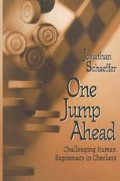Abstract
So, who was this great Marion Tinsley, world checkers champion, whom I kept hearing about? Supposedly he was good, but how good could that be? After all, the world of chess clearly showed that even the world champions were mortals, losing a game or two a year. But the vibrations I felt from the checkers players told me there was something special here. It was with reverence, not disrespect, that players referred to him as the Terrible Tinsley. Everyone was afraid of him, but only for his play over the board. Away from the board he was universally liked. It seemed as if everyone considered him to be their friend.
Access this chapter
Tax calculation will be finalised at checkout
Purchases are for personal use only
Preview
Unable to display preview. Download preview PDF.
References
William Hartston, “Can God Beat the Computer,” The Independent, August 17, 1992.
From Checkers the Tinsley Way, p. 70 (see Further Reading).
Ibid., p. 82.
Ibid., p. 89.
Ibid., p. 144.
Quoted from: D onna St. George, “ T he U nsung Champion of Checkers,” Philadelphia Inquirer, A pril 11, 1993.
Jim Propp, Massachusetts Institute of Technology, unpublished document.
In a simultaneous exhibition, the champion usually plays twenty to forty opponents at the same time. You make a move on one board and then move on to the next, going around the room in circles until all the games are completed.
The Independent, August 17, 1992.
Jim Propp, Massachusetts Institute of Technology, unpublished document.
Raymond Keene, Byron Jacobs, and Tony Buzan address this question in Man v Machine: The ACM Chess Challenge, B.B. Enterprises, Sussex, Great Britain, 1996. The only serious contender (in my opinion) is Oyama Yasuharu. He was a strong shogi (Japanese chess) player for forty-five years, during twenty of which he totally dominated the sport.
Author information
Authors and Affiliations
Rights and permissions
Copyright information
© 1997 Springer Science+Business Media New York
About this chapter
Cite this chapter
Schaeffer, J. (1997). As Close to Perfection As Humanly Possible. In: One Jump Ahead. Springer, New York, NY. https://doi.org/10.1007/978-1-4757-2733-3_9
Download citation
DOI: https://doi.org/10.1007/978-1-4757-2733-3_9
Publisher Name: Springer, New York, NY
Print ISBN: 978-1-4757-2735-7
Online ISBN: 978-1-4757-2733-3
eBook Packages: Springer Book Archive

